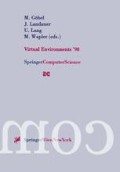Abstract
The key to insight is coupling the power of the computer with unique skills of the human. At Sandia National Laboratories’ Interaction Laboratory, we call this teraflop visualization. We are concentrating research in three main areas: 1) using the computer as a facility for authoring content, 2) adding the physics to model real behaviors, and 3) allowing the human to utilize the improved precision and resolution provided by this new class of compute power.
Access this chapter
Tax calculation will be finalised at checkout
Purchases are for personal use only
Preview
Unable to display preview. Download preview PDF.
References
Boff, K. R., L. Kaufman and J.P. Thomas, Eds. Handbook of Perception and Human Performance, New York: John Wiley and Sons, 1986.
Brooks, F.P, Jr., “The Computer Scientist as Toolsmith: Studies in Interactive Computer Graphics,” Information Processing 77, B. Gilchrist, ed., Amsterdam: North-Holland, 1977, pp. 625–634.
Cruz-Neira, C., Sandin, D.J., DeFanti, T.A., Kenyon, R., and Hart, J.C. The CAVE, Audio Visual Experience Automatic Virtual Environment. Communications of the ACM, June 1992.
Kokjer, K., “The Information Capacity of the Human Fingertip,” IEEE Transactions on Systems, Man and Cybernetics, 1987, Vol. SMC-17, No. 1, pp. 100–102.
Pagels, H., The Dreams of Reason, New York: Simon & Schuster, 1988.
Pfeiffer, J. E., The Creative Explosion: An Inquiry into the Origins of Art and Religion, Ithaca, NY: Cornell University Press, 1982.
Sutherland, I., “The Ultimate Display,” Proceedings of the IFIP Congress, 1965, pp. 506–508.
Thomas, J., “The Shape of Things to Come,” Proceedings of VR Systems ‘93 Conference, New York, NY, pp. 342–346, March, 1993.
Author information
Authors and Affiliations
Editor information
Editors and Affiliations
Rights and permissions
Copyright information
© 1998 Springer-Verlag/Wien
About this paper
Cite this paper
Breckenridge, A.R. (1998). Teraflop Visualization. In: Göbel, M., Landauer, J., Lang, U., Wapler, M. (eds) Virtual Environments ’98. Eurographics. Springer, Vienna. https://doi.org/10.1007/978-3-7091-7519-4_3
Download citation
DOI: https://doi.org/10.1007/978-3-7091-7519-4_3
Publisher Name: Springer, Vienna
Print ISBN: 978-3-211-83233-2
Online ISBN: 978-3-7091-7519-4
eBook Packages: Springer Book Archive

